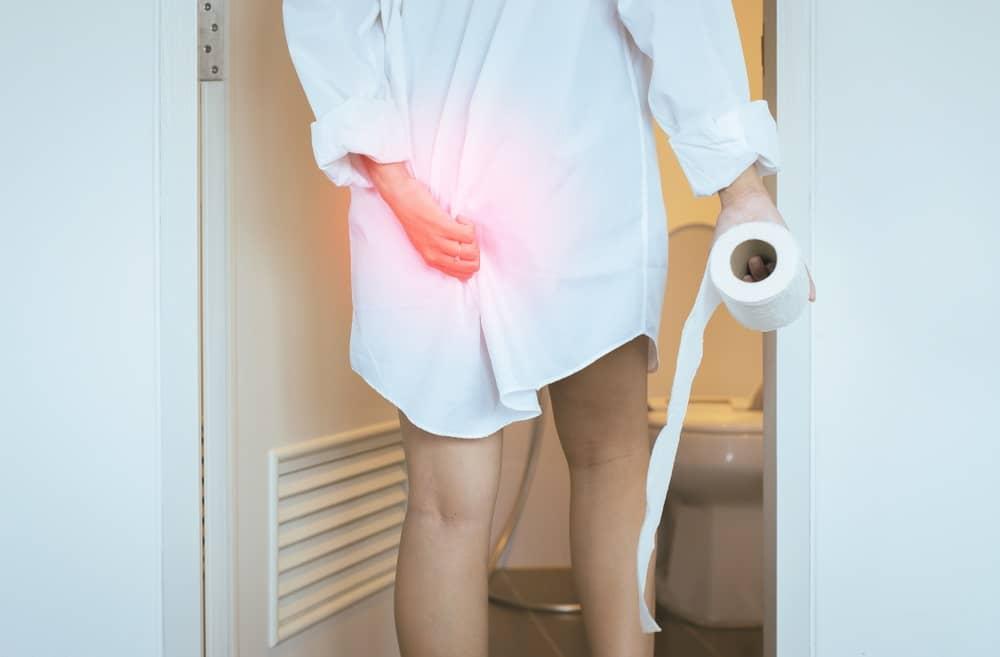Mucus in the stool should not be underestimated. Diet and serious illness can be to blame<
7/8/2021/Barbora Košňarová/ Articles/ 0 comments
Although regular stool inspection may seem unpleasant to some people, you should not underestimate it. Its appearance, structure and smell can reveal a lot about the patient's current state of health and at the same time draw attention to the development of health problems or even serious ongoing diseases. We will tell you what the causes of mucous stool are and what the mucus in the stool in an infant signals.
Normal stools
Excretion of waste substances is one of the basic and vitally important functions of the human body. At the same time, doctors consider stool that is brown in color, cylindrical in shape, has a slight odor and a consistency that can be compared to toothpaste, for example, to be normal. However, all these factors may vary depending on the current state of the digestive system and the health of a particular patient.
However, the consistency and color of stool also depends on what a person ate and drank the previous day. Therefore, short-term changes may not mean anything bad, especially when everything returns to normal within a few visits to the toilet. However, if the change in color, structure or odor persists for a long time, it may be the result of health problems that should not be ignored.
Various abnormalities:
Mucus in the stool
Mucus is one of the natural products of the human body, which is important for its proper functioning. This secretion appears, for example, as the lining of the nasal cavity, and the tissues that produce it ensure the protection of the mouth, throat, nose, paranasal sinuses, digestive tract, lungs or intestines. Under normal circumstances, it has a transparent color, but in case of illness, the shade often changes.
If you have found mucus in your stool, you don't need to worry right away. In any case, this is not an isolated phenomenon, because a certain amount of mucus-like substances is formed in the intestine even under normal circumstances. Once in a while, therefore, mucous stool appears in each of us, regardless of gender and age. That something is wrong is more likely to be indicated by an increased amount of stool with mucus and the presence of accompanying symptoms.
And what does the mucus in the stool look like? It is a thick and relatively smooth substance that is usually present on the surface of the stool, resembles any other mucus produced by the mucous membranes of the human body, and can have different colors (from transparent to white to yellow or green). To a lesser extent, mucusy stools are quite common, but if they also contain blood and pus or have a strange smell, it's time to see a doctor.
Mucous stools: causes
The small layer of mucus that forms the lining of the large intestine facilitates emptying, and the occasional presence of a small amount of mucus in the stool is completely normal. At the same time, the increased consumption of dairy products, which can change the color of the stool in the short term, may be to blame. Transparent, white or yellow mucus in the stool is, however, undetectable or completely rare in healthy patients.
The presence of mucus in the stool can also be caused by intestinal parasites, such as tapeworms or roundworms, whose eggs strongly resemble mucous secretions. Mucous stools are often also related to a lack of fluids, constipation or an increased incidence of bacteria in the small intestine, when the patient may notice a worsening of the problem after consuming sugar in any form (white sugar, bread, pasta, etc.).
To make matters worse, food allergies and intolerances are also to blame, specifically nut allergies, celiac disease (gluten intolerance) or lactose intolerance. The consumption of certain foods causes a number of unpleasant symptoms in patients, including the presence of mucus in the stool.
If a large amount of mucus begins to appear in the stool, the patient experiences a number of unpleasant accompanying symptoms or even notices blood and mucus in the stool, it is time to immediately seek a doctor who will perform the necessary examinations. These complications can be related to the development of more or less serious diseases, which could even threaten the patients' lives.
When it comes to yellow mucus in the stool, it can also be a sign of rapid passage of food through the digestive tract (for example, in patients with gastroesophageal reflux). It can also be to blame:

If green mucus appears in the stool, doctors also recognize a number of possible causes. One of them is the consumption of foods rich in chlorophyll, such as spinach, leafy greens or broccoli. However, if this substance appears in the stool repeatedly and for a long time, it is probably a symptom of some health problems. This mainly includes:
Non-specific intestinal inflammations
Non-specific inflammations of the intestinal mucosa are most often responsible for the presence of mucus in the stool. These in themselves are not that dangerous, but they cause unpleasant irritation of the mucous membrane, which leads to the development of many different health complications. Typical symptoms include abdominal pain, weight loss and the presence of mucus in the stool, which is sometimes even mixed with blood.
One of the given inflammations is Crohn's disease, which doctors also refer to as regional enteritis. It is an autoimmune disease where the patient's body attacks its own cells. Any part of the digestive system can be affected, from the oral cavity through the small intestine to the anus. The causes of this disease are not yet fully known, but risk factors include stress, smoking, unhealthy diet and genetic predispositions.
Another possible problem is ulcerative colitis (idiopathic proctocolitis), which is an autoimmune type of inflammation of the digestive tract. It usually starts by affecting the anus and then spreads throughout the large intestine, where it damages the mucous membrane and causes ulcers that can ooze blood and pus. Multiple factors are likely to contribute to the development of this disease, with typical symptoms including abdominal pain, diarrhoea, cramps, general weakness, loss of appetite or bloody mucus in the stool.Irritable Bowel Syndrome
Among the most common causes of mucus in the stool is Irritable Bowel Syndrome, also known as Irritable Bowel Syndrome (IBS). It is an unpleasant disease of the large intestine that affects approximately 20% of the population (mainly patients of working age) and affects women somewhat more often.
It is manifested by a compulsive and repeated need to defecate, which is also accompanied by pain and cramps in the abdomen, flatulence, constipation, diarrhea or just excessive production of intestinal mucus. However, patients should not have any other warning symptoms, such as blood in the stool, significant weight loss or high fever.
Intestinal infectious diseases
Mucus in the stool can also be caused by a number of infections that affect the intestinal mucosa. These are mostly diseases of bacterial origin, and these problems most often occur during infection with dysentery, campylobacter or salmonella.
Hemorrhoids
The presence of mucus in the stool often accompanies hemorrhoidal disease. In this case, the expansion and swelling of vascular bundles in the area of the anus and anus is to blame, which causes a number of unpleasant problems for patients. In addition to increased mucus production, it can also be bleeding from the anus, a feeling of the presence of a foreign body or persistent itching, and patients also observe bloody mucus in the stool during diarrhea.
Anal fissures and rectal ulcers
Although normal bowel movements do not produce large amounts of mucus, the situation can quickly change due to the presence of anal fissures and ulcers in the rectal mucosa. These are unpleasant complications that are accompanied by significant pain in the area, but also unpleasant itching, mucous stools and bleeding from the anus.
Colon and rectal cancer
Mucus in the stool can simultaneously be one of the characteristic symptoms of colorectal cancer, which is the second most commonly diagnosed oncological disease in the world. Intestinal tumor growth irritates the mucous membrane, which reacts to this situation by increasing mucus secretion. In addition, symptoms include alternating diarrhea and constipation, pressure in the intestines, unintentional weight loss, a feeling of poor emptying of the bowel or passing stool in a narrow strip.
Accompanied symptoms
Repeated or long-term presence of mucus in the stool is a signal that the patient should contact his attending physician to be sure and consult with him about the next course of action. Difficulties that appear together with the problem described above also signal that something is wrong. Symptoms that may accompany mucus in the stool include:
Although the presence of mucus in the stool together with the development of other health complications may not mean any major problem, in some cases the patient's life may even be at risk. You should therefore seek medical help as soon as possible if significant bleeding from the anus, high fever or pus in the stool occurs.
Other difficulties that you definitely should not underestimate include abdominal stiffness, rectal or anal pain, vomiting blood, tachycardia (rapid heartbeat) and a change in behavior or mental state (general confusion, hallucinations and delusions). In addition, any changes in the patient's state of consciousness and alertness, such as disturbances in perception or fainting, should also be noted.
Diagnosis
If the patient notices the presence of mucus in the stool, a complete examination of his stool should be performed. First, the patient should clarify to the doctor the exact nature of the difficulties (consistency, color, shape and smell of the stool, color and consistency of mucus, possible bleeding) and at the same time describe any accompanying symptoms that he has recently noticed.
If an infection is suspected, it is necessary to carry out a culture examination of the stool sample, which will reveal the presence of bacteria or parasites, as well as some diseases. Other tests performed include laboratory blood tests, colonoscopy (examination of the large intestine using a probe), endoscopy, X-ray of the abdomen, ultrasound examination or CT examination.
Mucus in the stool: treatment
Treatment of the problem naturally depends on the underlying cause, as different medical complications also require different therapeutic methods. In the case of a bacterial infection, treatment with antibiotics is appropriate. However, these can eliminate the beneficial intestinal microflora, which is why they are also combined with the use of probiotics, which replenish the microorganisms in the digestive tract.
If a food allergy or intolerance is to blame, a suitable method of treatment is a change in lifestyle and the permanent removal of problematic foods from the menu. Crohn's disease is usually treated with medication (antibiotics in the acute phase, corticosteroids or immunosuppressants in the chronic phase) and a suitable diet. Another option is biological treatment or surgery.
Treatment of ulcerative colitis depends mainly on the stage of the disease. In the acute stage, doctors focus on managing the inflammation, during the period of remission, patients must focus on prevention. Medicines are prescribed in the form of tablets, suppositories and enemas, a special diet also plays an important role, and other therapeutic options include, as in the case of Crohn's disease, biological and surgical treatment.
Probiotics can help with problems such as constipation or diarrhea. Patients with anal fissures and rectal ulcers can undergo surgery to relieve their problems. Hemorrhoids are then treated using conservative, semi-invasive and surgical methods, depending on the intensity of the problem, and if the patient suffers from irritable bowel syndrome, the therapy focuses on suppressing unpleasant symptoms and achieving long-term mental and physical well-being of the patient.
The treatment of colon and rectal cancer always depends on the extent of the disease and the stage at which it is caught. Surgical removal of the entire tumor, subsequent chemotherapy and radiotherapy, or perhaps biological treatment, which stimulates the immune system to destroy malignant tissue and prevent the tumor from spreading to unaffected parts of the body, can help.
Mucus in stools in children
Although mucous stools in babies are not unusual, some parents can be very concerned. However, children's colds are to blame, for example, because babies are not yet able to blow their noses properly and therefore swallow a significant part of the cold mucus. The mucus then passes through their entire digestive tract and is excreted together with the stool.
Mucus in an infant's stool can also appear due to bad intestinal microflora, for example, as a result of a yeast infection that can develop on the basis of artificial milk administration or after cesarean delivery. The transition to non-dairy foods can also be problematic, which causes a change in the character of the child's stool.
Green slimy stools in infants are mainly related to teething. If it is a short-term issue and the baby does not suffer from any other accompanying symptoms, there is no need to worry too much. However, green stools with mucus can also be caused by the consumption of large amounts of chlorophyll-rich foods (peas, broccoli, spinach, cabbage), and not only in children.
Of course, the above-mentioned causes of mucus in the stool do not mean that, in the case of small patients, more serious health complications cannot also be to blame. Therefore, if a baby's mucous stool appears, the presence of which is also accompanied by other difficulties, or you even notice bloody mucus in the stool in children, do not hesitate to contact a doctor and discuss the problem with him.
Sources: stefajir.cz, cs.medlicker.com, linkos.cz


 Tags:
Tags: Prev
Prev







